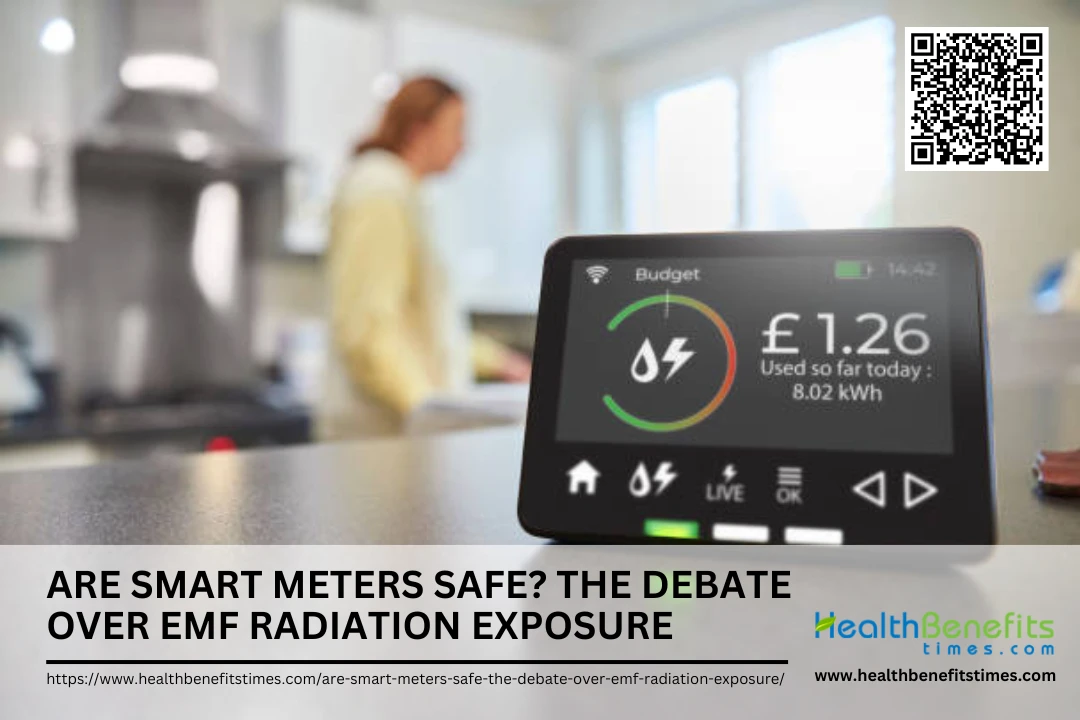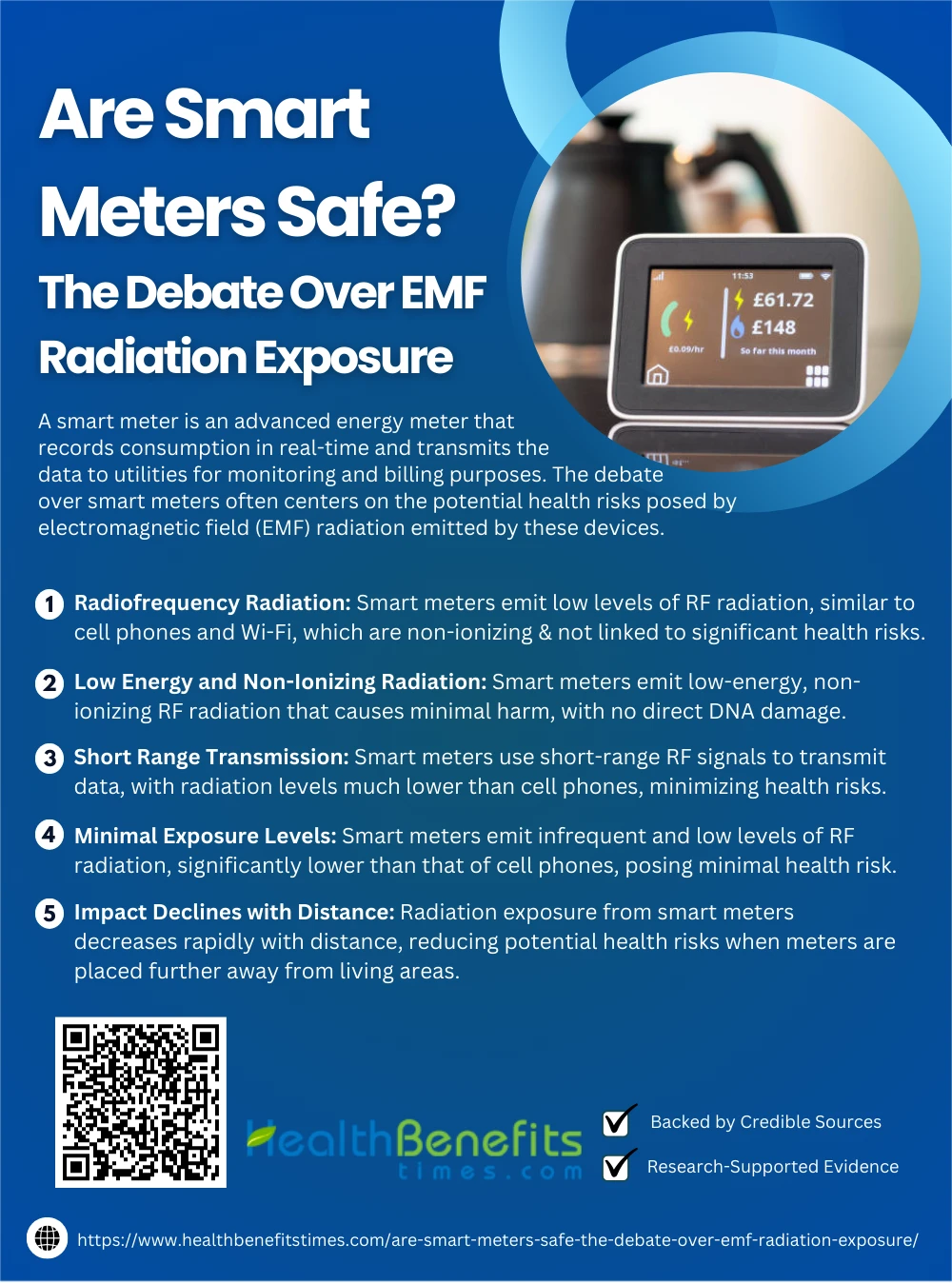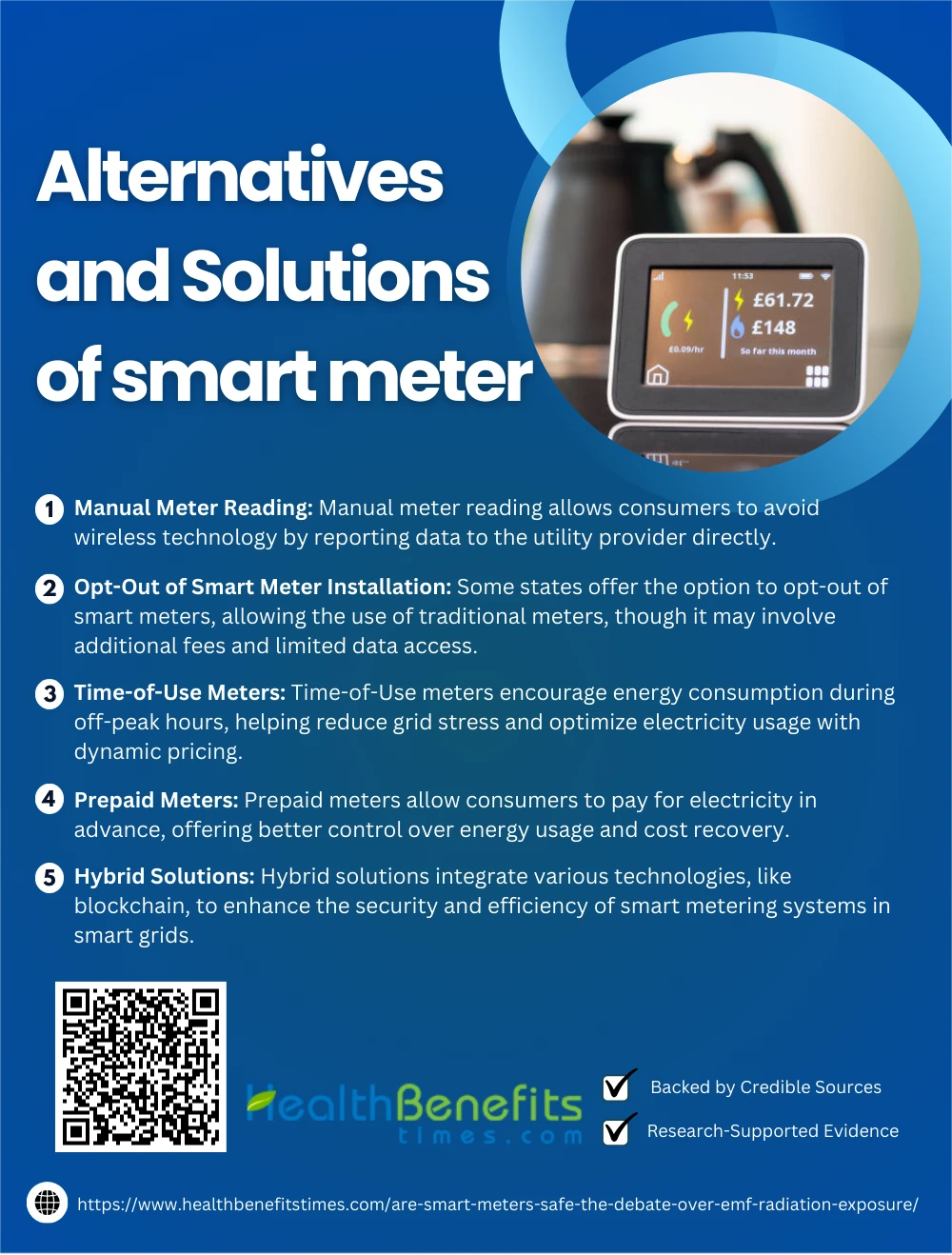- A smart meter is an advanced energy meter that records consumption in real-time and transmits the data to utilities for monitoring and billing purposes.
- The debate over smart meters often centers on the potential health risks posed by electromagnetic field (EMF) radiation emitted by these devices.
- While studies generally conclude that smart meters emit low levels of EMF radiation, public concerns about their long-term health effects continue to spark controversy.
 Radiation refers to the emission of energy in the form of electromagnetic waves or particles. This can range from non-ionizing radiation, such as that emitted by common household devices, to ionizing radiation, which has higher energy and is capable of causing damage to biological tissues. Smart meters, which are increasingly being installed in homes and businesses for energy management purposes, are a key part of the ongoing debate surrounding electromagnetic field (EMF) radiation exposure. While these devices provide significant benefits, such as real-time data on energy consumption and improved efficiency, concerns have been raised about the potential health risks associated with their EMF emissions. Numerous studies explore the impact of low-level EMF exposure, particularly from devices like smart meters, on human health. The American Cancer Society, for instance, addresses the potential link between EMF radiation and cancer risk, noting that most evidence does not conclusively prove that EMF exposure from smart meters poses a significant health threat. However, the debate continues, with some advocating for more research and cautionary measures, while others argue that the emissions are well within safe limits defined by international standards.
Radiation refers to the emission of energy in the form of electromagnetic waves or particles. This can range from non-ionizing radiation, such as that emitted by common household devices, to ionizing radiation, which has higher energy and is capable of causing damage to biological tissues. Smart meters, which are increasingly being installed in homes and businesses for energy management purposes, are a key part of the ongoing debate surrounding electromagnetic field (EMF) radiation exposure. While these devices provide significant benefits, such as real-time data on energy consumption and improved efficiency, concerns have been raised about the potential health risks associated with their EMF emissions. Numerous studies explore the impact of low-level EMF exposure, particularly from devices like smart meters, on human health. The American Cancer Society, for instance, addresses the potential link between EMF radiation and cancer risk, noting that most evidence does not conclusively prove that EMF exposure from smart meters poses a significant health threat. However, the debate continues, with some advocating for more research and cautionary measures, while others argue that the emissions are well within safe limits defined by international standards.
What Are Smart Meters?
Smart meters are advanced devices used to measure energy consumption in homes and businesses. They work by wirelessly transmitting data on electricity, gas, or water usage to utility companies in real-time. Unlike traditional meters, which require manual reading, smart meters provide instant feedback on energy usage and can communicate with utilities without the need for human intervention. This system allows for more accurate billing and better management of energy resources.
Smart meters play a crucial role in energy management by offering consumers and utility companies detailed, up-to-the-minute data on energy consumption. This helps utility companies optimize energy distribution and reduce waste by identifying peak demand periods. Additionally, smart meters allow consumers to monitor and control their energy usage more effectively, potentially leading to cost savings. The real-time data also enhances grid reliability and can facilitate the integration of renewable energy sources.
The benefits of smart meters extend beyond simple energy tracking. These devices can improve grid efficiency, support more accurate billing, and empower consumers to adjust their usage for lower energy costs. By providing detailed consumption data, smart meters also help identify areas where energy can be conserved, contributing to environmental sustainability. Furthermore, smart meters assist utilities in detecting faults or outages faster, ensuring more reliable service.
Differences between traditional meters and smart meters.
Here’s a comparison table differentiating between traditional meters and smart meters:
| Feature | Traditional Meters | Smart Meters |
| Reading Method | Manual reading by utility personnel | Automated, real-time data transmission to utilities |
| Data Transmission | Requires physical visits for meter readings | Wirelessly transmits usage data to the utility company |
| Accuracy | Prone to human error and estimation issues | Provides highly accurate, real-time data |
| Billing | Based on estimated consumption or manual readings | Based on actual usage, reducing estimation errors |
| Consumer Interaction | Limited; consumers receive bills periodically | Consumers can track usage in real-time via apps or websites |
| Energy Efficiency | No direct insight into usage patterns | Provides detailed insights into energy consumption, enabling better energy management |
| Cost | Typically lower upfront cost | Higher initial cost due to advanced technology |
| Environmental Impact | Potential inefficiency in energy consumption | Encourages energy conservation through real-time data and insights |
| Grid Management | Less efficient, harder to detect issues or outages | Enables quick identification of grid issues, improving reliability |
| Installation | Requires a physical visit by a technician for setup | Often remotely installed or can be set up with minimal intervention |
Understanding EMF Radiation
Electromagnetic Field (EMF) radiation refers to the energy emitted by electric and magnetic fields that oscillate at varying frequencies. There are two main types of EMF radiation: low-frequency radiation, which includes electric and magnetic fields from household appliances, and high-frequency radiation, such as radiofrequency (RF) waves emitted by devices like cell phones and smart meters. In everyday life, EMF radiation is emitted by a range of devices, including microwaves, power lines, and Wi-Fi routers. Smart meters, which are used to measure and transmit utility data, emit low-level RF radiation during their communication with utility companies, typically through wireless signals.
The Science behind EMF Exposure and Health Risks
Electromagnetic fields (EMF) are present in our environment from various sources, such as power lines, cell phones, and household appliances. EMF exposure, particularly from radiofrequency radiation, has raised concerns due to its potential health risks. Some studies suggest that prolonged exposure to high levels of EMF may be linked to various health issues, including increased cancer risk and neurological problems. However, research on low-level exposure, such as that from smart meters, is still inconclusive. According to studies, smart meters emit low-frequency electromagnetic radiation during their data transmission to utility companies, but current evidence does not conclusively link this to any significant health hazards.
Are Smart Meters Safe?
Smart meters, while generally regarded as safe, have raised some concerns among the public. The most common worry revolves around the radiofrequency (RF) radiation they emit. However, studies have shown that the RF radiation from smart meters is far below the limits set by the Federal Communications Commission (FCC) and is significantly less than that produced by devices such as cell phones, baby monitors, and microwave ovens. According to the American Cancer Society, the radiation levels from smart meters are too low to significantly increase the risk of health problems, including cancer American Cancer Society. (1) Despite this, privacy concerns are often raised, as smart meters collect detailed data on household energy usage. While this data is valuable for energy suppliers, critics argue that it could potentially be misused, even though it doesn’t include personal information like names or addresses The Telegraph. (2) Moreover, individuals living near smart meters are advised to keep a safe distance to avoid any potential impact on sleep, with suggestions that smart meters be placed at least two rooms away from bedrooms EMF Center. (3) Thus, while smart meters are generally safe in terms of RF radiation, concerns about privacy and their impact on sleep remain topics for further consideration.
How smart meter emits EMF Radiation
Smart meters emit EMF radiation through wireless communication, using radio frequency (RF) signals to transmit data to utility companies. These signals create electromagnetic fields that vary in frequency, intensity, and duration.
 1. Radiofrequency (RF) Radiation
1. Radiofrequency (RF) Radiation
Smart meters emit radiofrequency (RF) radiation, similar to the radiation emitted by cell phones and Wi-Fi devices, to communicate data over short distances. This type of radiation is non-ionizing and does not have enough energy to damage DNA directly. The American Cancer Society states that although smart meters emit RF radiation, the levels are low and not associated with significant health risks, including cancer American Cancer Society. (1) The EPA explains that RF energy from smart meters is classified as non-ionizing radiation, and exposure limits are regulated to ensure safety EPA. (4) While concerns persist, studies show that the emitted radiation is well below safety thresholds. Additionally, Tech Wellness recommends keeping smart meters away from living areas to reduce exposure further Tech Wellness. (5) Further protection measures like EMF filtering can also reduce RF exposure Belmont Solar. (6)
2. Low Energy and Non-Ionizing Radiation
Smart meters emit low-energy, non-ionizing radiation, which is a type of radiofrequency (RF) radiation. This radiation is not powerful enough to directly damage DNA, unlike more harmful radiation types such as UV or x-rays. According to the American Cancer Society, RF radiation from smart meters is absorbed by the body in a way that only causes slight vibration of atoms, resulting in heat rather than harm American Cancer Society. (1) The Canadian Health Services also confirm that RF energy emitted from smart meters falls under the category of non-ionizing radiation Canada.ca. Experts from Tech Wellness suggest that the exposure risk is negligible, especially if smart meters are placed away from frequently used living spaces Tech Wellness. (5) Additionally, the Environmental Health Trust recommends strategies for reducing exposure, like EMF filtering and reducing time spent near the meter Belmont Solar. (6)
3. Short Range Transmission
Smart meters typically use short-range transmission to send data to utility companies. This is achieved through radiofrequency (RF) signals, which transmit meter readings over distances of up to 100 meters. The EPA explains that this kind of transmission uses low-power RF energy similar to Wi-Fi and mobile phones EPA. (4) The American Cancer Society notes that these emissions are minimal, and the radiation levels are much lower than those of a cell phone, making health risks unlikely American Cancer Society. (1) While Environmental Health Trust highlights concerns about proximity to the meter, they recommend maintaining a distance of at least 20 cm to avoid high radiation exposure Environmental Health Trust. (7) Transmission occurs in pulses, which means it’s not continuous, further minimizing potential risk.
4. Minimal Exposure Levels
Smart meters emit minimal exposure levels of radiation, primarily due to the infrequent transmission of data signals. The exposure is much lower compared to common devices such as cell phones. According to Honeywell Safety Data Sheets, smart meters transmit infrequent signals, resulting in reduced overall exposure compared to other wireless devices Honeywell. The American Cancer Society also emphasizes that the RF radiation from smart meters is much lower than that emitted by cell phones American Cancer Society. (1) Furthermore, the Environmental Health Trust states that these devices operate within safe exposure levels set by global health guidelines Environmental Health Trust. As Telegraph mentions, smart meter concerns are more about privacy than health risks due to the data collected Telegraph. (2)
5. Impact Declines with Distance
The impact of smart meter radiation significantly decreases with distance from the source. Research indicates that when the distance from the meter doubles, the radiation intensity reduces by four times CSE. (8) This phenomenon helps minimize any potential health risks as the Environmental Health Trust suggests keeping smart meters away from sleeping areas for lower exposure Environmental Health Trust. The EPA also supports this by explaining that RF exposure diminishes quickly as one moves further from the device EPA. (4) Citizens Advice further encourages placing meters in less frequented spaces to reduce any radiation exposure Citizens Advice. (9)
Alternatives and Solutions of smart meter
For those concerned about smart meters, alternatives include opting for traditional analog meters or using EMF shielding devices. Solutions also involve reducing exposure by limiting proximity to smart meter installations.
Manual meter reading remains a viable alternative to smart meters, especially for individuals who prefer not to use wireless technology or are concerned about privacy. Traditional meters require consumers to physically read the meter and report the data to the utility provider, which eliminates the need for remote data transmission. This method is a common choice for those opting out of smart meters due to concerns over privacy or radiation exposure Meter Corp. (10) Although less convenient, it offers direct control over readings and data handling SO Energy. (11)
2. Opt-Out of Smart Meter Installation
The installation of smart meters has raised privacy and safety concerns, prompting many consumers to seek alternatives. Some states allow for opting out of smart meter installations, offering customers the option of using traditional analog meters instead. Studies have shown that opting out is not a one-size-fits-all solution, as it can involve additional fees and limited access to real-time data. Research by the National Conference of State Legislatures explores this issue, highlighting the legal and regulatory challenges surrounding the opt-out process. In some cases, individuals may opt for alternatives such as manual meter readings or remote data collection systems to monitor their consumption. Energy Policy Solutions has also proposed implementing hybrid meters that combine some features of smart meters with consumer privacy in mind. (12)
3. Time-of-Use Meters
Time-of-Use (TOU) meters are an essential component of smart grids, offering a dynamic pricing model to optimize electricity usage. These meters measure energy consumption at different times of day, encouraging consumers to shift energy use to off-peak hours, thereby reducing grid stress and enabling better energy management. TOU tariffs are particularly valuable in deregulated markets, where electricity prices fluctuate based on demand. A study highlights the role of smart meters in optimizing energy consumption under TOU tariffs Predicting intra-day load profiles, (13) while another review discusses the functionalities of smart meters in smart grids Smart metering and functionalities. (14) Additionally, research on the impact of TOU tariffs on consumer behavior shows that they can lead to significant energy savings Smart choices? An experimental study. (15)
4. Prepaid Meters
Prepaid meters are a cost-effective alternative to traditional smart meters, allowing consumers to pay for electricity in advance. This system has been particularly effective in regions with unstable grid infrastructure. Studies suggest that prepaid meters offer advantages in cost recovery and consumer control over energy consumption. A report explores the effectiveness of prepaid systems in the UK Smart pre-payment in Great Britain, while another analysis evaluates the cost-benefit of prepaid meters in electricity Prepaid Meters in Electricity. (16) A further review considers prepaid metering as a viable solution for managing electricity demand in Pakistan Prepaid metering: A way forward. (17)
5. Hybrid Solutions
Hybrid solutions combine multiple technologies to enhance smart metering systems, such as integrating blockchain with secure energy gateways for improved security Blockchain and secure element. (18) These systems are essential in smart grids where diverse energy sources and control systems require seamless integration. A comprehensive review of behind-the-meter energy storage systems in smart grids presents hybrid solutions as crucial for enhancing energy efficiency A review of behind-the-meter energy storage systems. (19) Additionally, hybrid energy systems using metering solutions can improve microgrid configurations Metering systems and demand-side management models. (20)
Conclusion
In conclusion, the safety of smart meters remains a contentious issue, with conflicting views surrounding EMF radiation exposure. While many experts and regulatory bodies assert that the levels of EMF radiation emitted by smart meters are well within safe limits, concerns persist, particularly among those who are sensitive to electromagnetic fields. It’s important to consider the available research, regulatory guidelines, and individual preferences when deciding whether to accept smart meter installation. Ultimately, further research and awareness are needed to address the health implications fully, allowing consumers to make informed decisions based on scientific evidence and personal comfort.



